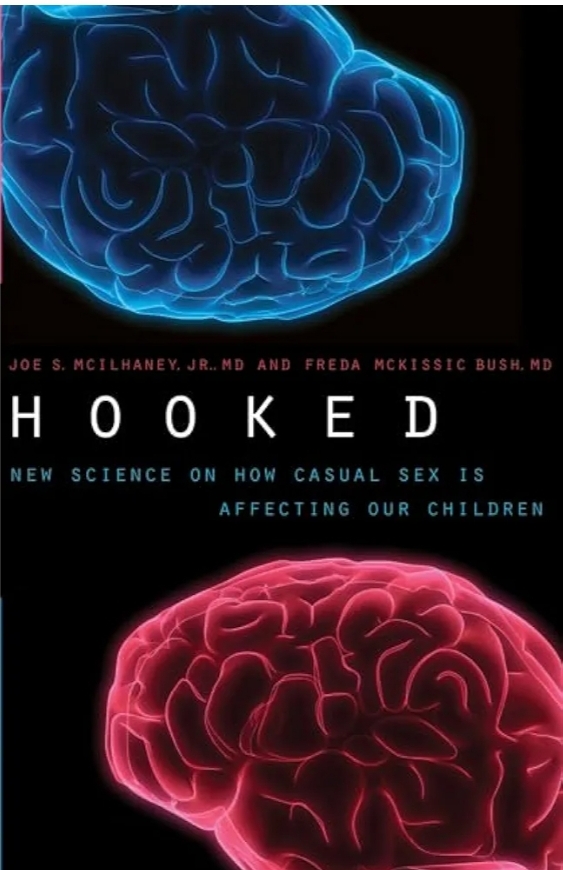“Hooked: New Science on How Casual Sex is Affecting Our Children” by Joe S. McIlhaney Jr. and Freda McKissic Bush – In Detail
Overview of the Book
Hooked explores the biological, psychological, and emotional consequences of casual sexual relationships, particularly among teenagers and young adults. Dr. Joe S. McIlhaney Jr. and Dr. Freda McKissic Bush, both medical professionals, draw upon neuroscientific research and clinical observations to argue that casual sex has lasting effects on brain development, emotional health, and relationship stability.
The book emphasizes how neurochemicals like dopamine, oxytocin, and vasopressin—critical for bonding and emotional connection—are significantly affected by repeated casual sexual encounters. It likens the brain’s bonding mechanism to tape losing its stickiness after being applied and removed multiple times.
The Science Behind Sexual Bonding and the Brain
a. The Role of Neurochemicals in Bonding
The book highlights three primary neurochemicals involved in sexual bonding:
- Dopamine: Known as the “pleasure chemical,” dopamine is released during pleasurable activities, including sex. It creates a reward loop, reinforcing the desire for repeated behavior.
- Oxytocin: Often called the “bonding hormone,” oxytocin is released during sex, childbirth, and breastfeeding. It fosters emotional attachment and trust.
- Vasopressin: More prominent in men, vasopressin promotes protective and attachment behaviors after sex.
When a person engages in sexual activity, these neurochemicals are released, creating emotional and psychological bonds with their partner.
b. The “Tape Analogy” Explained
The book uses the analogy of adhesive tape to explain the brain’s bonding mechanism:
- First Bonding: The first few times tape is applied and removed, it sticks well and forms a strong bond.
- Repeated Use: The more often tape is stuck and removed, the less adhesive it retains, and eventually, it stops sticking effectively.
- Human Bonding Parallel: Each sexual partner creates a neurochemical bond. But repeated casual sexual encounters without lasting commitment weaken the brain’s ability to form deep, emotional bonds in future relationships.
This analogy underscores how casual sex can diminish a person’s capacity for long-term, meaningful emotional connections.
Emotional and Psychological Consequences
a. Increased Risk of Depression and Anxiety
- Research cited in the book shows a higher prevalence of depression and anxiety among individuals with multiple sexual partners, particularly in teenagers.
- Neurochemical imbalances caused by repeated bonding and detachment contribute to feelings of emotional emptiness and insecurity.
b. Reduced Ability to Trust and Commit
- When individuals repeatedly form and break intimate bonds, their brains may become less responsive to oxytocin and vasopressin, diminishing their ability to trust and commit to future partners.
- This pattern creates a cycle of emotional detachment, often leading to dissatisfaction in long-term relationships.
c. Increased Risk of Addiction-like Behavior
- The dopamine-driven reward cycle associated with casual sex can mimic patterns seen in substance addiction.
- The pursuit of pleasure through casual encounters may become compulsive, overriding healthier emotional attachments.
Impact on Teenagers and Young Adults
a. Brain Development During Adolescence
- The adolescent brain is still developing critical structures and neural pathways, particularly in areas responsible for decision-making, impulse control, and emotional regulation (prefrontal cortex).
- Casual sex during this vulnerable period can disrupt the brain’s development, making it harder for teenagers to form stable emotional bonds later in life.
b. Emotional Immaturity and Long-Term Consequences
- Teens are often emotionally unprepared for the intense neurochemical bonding that comes with sexual activity.
- The emotional aftermath of casual sex can lead to feelings of regret, self-doubt, and worthlessness.
c. The Role of Peer Pressure and Media
- The book discusses how media, cultural norms, and peer pressure normalize casual sex, creating an environment where emotional and psychological consequences are downplayed.
Social and Cultural Implications
a. The Hook-Up Culture
- Modern society often romanticizes and encourages casual sex through media, music, and movies.
- This cultural shift minimizes the significance of emotional bonding and long-term commitment in relationships.
b. Disconnect Between Physical Intimacy and Emotional Connection
- The separation of physical intimacy from emotional and spiritual connection contributes to a culture where sex is viewed as a mere transaction rather than an act of bonding.
c. Long-Term Effects on Marriage and Family Stability
- Studies show that individuals who have had multiple sexual partners before marriage are more likely to experience divorce and relationship dissatisfaction.
- The weakened ability to bond emotionally makes sustaining lifelong partnerships more challenging.
Recommendations from the Authors
a. Encouraging Abstinence and Delayed Sexual Activity
- McIlhaney and Bush advocate for abstinence or delaying sexual activity until a committed relationship, preferably marriage.
- They argue that such choices allow individuals to form healthier, lasting emotional bonds.
b. Educating Teens About the Brain’s Role in Bonding
- Teaching teenagers about the neurochemical effects of sex helps them understand the emotional and psychological consequences of casual sexual encounters.
c. Building Emotional Intelligence and Healthy Relationships
- Promoting self-worth, emotional maturity, and meaningful connections can empower individuals to make wiser decisions about intimacy.
d. Community and Parental Involvement
- Parents, educators, and communities need to actively engage in conversations about sexual health, emotional well-being, and long-term consequences.
Bridging Science and Faith
The authors approach the topic not only from a scientific standpoint but also from a faith-based perspective:
- They emphasize that human beings are designed for connection, intimacy, and lifelong bonds.
- Spiritual beliefs about the sanctity of sex within committed relationships align with the biological realities revealed by neuroscience.
Conclusion
Key Takeaways from “Hooked”:
- Neurochemicals like dopamine, oxytocin, and vasopressin play a central role in emotional bonding.
- Repeated casual sexual encounters can weaken the brain’s ability to form lasting emotional connections.
- Adolescence is a critical period for brain development, making teenagers particularly vulnerable to the consequences of casual sex.
- Long-term emotional health, relationship satisfaction, and even societal stability depend on recognizing and respecting the emotional and neurochemical significance of sexual intimacy.
Final Thought: The message of Hooked is clear: sexual intimacy is not just a physical act but a profound emotional and neurochemical experience that shapes our ability to bond, trust, and love. Recognizing this reality is crucial for fostering healthier relationships, families, and societies.





